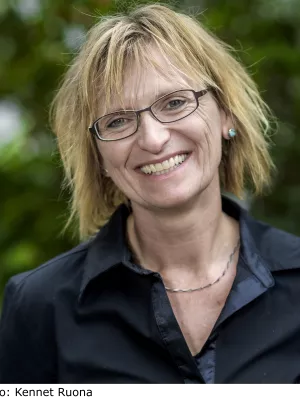
Natascha Kljun
Professor

The positive net radiative greenhouse gas forcing of increasing methane emissions from a thawing boreal forest‐wetland landscape
Författare
Summary, in English
At the southern margin of permafrost in North America, climate change causes widespread permafrost thaw. In boreal lowlands, thawing forested permafrost peat plateaus (‘forest’) lead to expansion of permafrost‐free wetlands (‘wetland’). Expanding wetland area with saturated and warmer organic soils is expected to increase landscape methane (CH4) emissions. Here, we quantify the thaw‐induced increase in CH4 emissions for a boreal forest‐wetland landscape in the southern Taiga Plains, Canada, and evaluate its impact on net radiative forcing relative to potential long‐term net carbon dioxide (CO2) exchange. Using nested wetland and landscape eddy covariance net CH4 flux measurements in combination with flux footprint modeling, we find that landscape CH4 emissions increase with increasing wetland‐to‐forest ratio. Landscape CH4 emissions are most sensitive to this ratio during peak emission periods, when wetland soils are up to 10 °C warmer than forest soils. The cumulative growing season (May–October) wetland CH4 emission of ~13 g CH4 m−2 is the dominating contribution to the landscape CH4 emission of ~7 g CH4 m−2. In contrast, forest contributions to landscape CH4 emissions appear to be negligible. The rapid wetland expansion of 0.26 ± 0.05% yr−1 in this region causes an estimated growing season increase of 0.034 ± 0.007 g CH4 m−2 yr−1 in landscape CH4 emissions. A long‐term net CO2 uptake of >200 g CO2 m−2 yr−1 is required to offset the positive radiative forcing of increasing CH4 emissions until the end of the 21st century as indicated by an atmospheric CH4 and CO2 concentration model. However, long‐term apparent carbon accumulation rates in similar boreal forest‐wetland landscapes and eddy covariance landscape net CO2 flux measurements suggest a long‐term net CO2 uptake between 49 and 157 g CO2 m−2 yr−1. Thus, thaw‐induced CH4 emission increases likely exert a positive net radiative greenhouse gas forcing through the 21st century.
Publiceringsår
2017
Språk
Engelska
Sidor
2413-2427
Publikation/Tidskrift/Serie
Global Change Biology
Volym
23
Issue
6
Dokumenttyp
Artikel i tidskrift
Förlag
Wiley-Blackwell
Ämne
- Climate Research
- Environmental Sciences
Nyckelord
- boreal forest
- carbon dioxide
- climate change
- eddy covariance
- methane
- radiative forcing
- wetland
Status
Published
ISBN/ISSN/Övrigt
- ISSN: 1354-1013